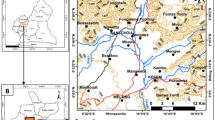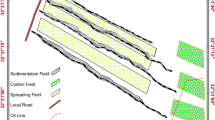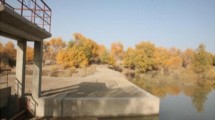Abstract
Flood spreading (FS) is one of the suitable methods for flood management and water harvesting that increases the groundwater recharge, makes soil more fertile and increases nutrients in soil. It is also a method for reusing sediment, which is usually wasted. The purpose of this paper is to investigate the impact of flood spreading on physical and chemical soil properties (soil texture, infiltration rate, pH, EC, Na, P, K, Ca, Mg, Cl, HCO3, and SO4). It is examined that the soil properties change in the flood spreading projection area (FSP). The physico-chemical properties of soil and infiltration rate were measured in different soil depths at both flood spreading and control area. For the 20 cm of top soil, the amount of clay increased after the flood spreading implementation especially in the first and second dikes. Increasing clay was accompanied by decreasing soil infiltration and sand percentage. The mean differences of the clay, sand and infiltration rate between FSP and the control area were statistically significant (P < 0.01). A significant difference was not observed in 20–30 cm of the depth. Soil pH, Mg, HCO3, Cl and SO4 in different soil layers did not show any significant difference between the control and FSP. Soil EC in 0–20 cm depth of FSP and control area was showed a significant difference (P < 0.05) but no significant differences were found in deeper layers (P < 0.05). K, Na and Ca were remarkably different between 0 and 10 cm depths (P < 0.05) whereas no significant differences were found in deeper layers (P < 0.05). Comparison of the physico-chemical properties and infiltration rates between the dikes in the FSP shows that there are the significant differences between the medians of dike 1 with dikes 2, 3, 4 and 5, but the differences were not observed between dikes 3, 4 and 5. Our results show that the flood spreading operation can be influenced by the area that is under this operation. This study allowed us to investigate the mechanisms that regulate the infiltration rate and chemical soil properties throughout a seasonally flooded area.
Similar content being viewed by others
Explore related subjects
Discover the latest articles and news from researchers in related subjects, suggested using machine learning.References
Artimo A, Sami S, Ylander I (2008) Methods for integrating an extensive geodatabase with 3D modeling and data management tools for the Virttaankangas Artificial Recharge Project, Southwestern Finland. Water Resour Manage 22(120):1723–1739
Al-Qudah KH, Abu-Jabe N (2009) A GIS database for sustainable management of shallow water resources in the Tulul al Ashaqif Region, NE Jordan. Water Resour Manag 23(3):603–615
Arabkhedri MA, Sarreshtehdari A, Kamali K (1997) The long time effect of flood harvesting on infiltration rate. In: Proceedings of the 8th international conference on rainwater catchment system, vol 2. Ministry of Jihad-e-Sazandegi, Tehran, pp 1157–1158
Boulton AJ (2000) River ecosystem health down under: assessing ecological condition in riverine groundwater zones in Australia. Ecosyst Health 6(2):108–118
Boulton AJ, Findlay S, Marmonier P, Stanley EH, Valett HM (1998) The functional significance of the hyporheic zone in streams and rivers. Ann Rev Ecolog Syst 29:59–81
Brunke M, Gonser T (1997) The ecological significance of exchange processes between rivers and groundwater. Freshw Biol 37:1–33
Cao W, Bowden WB, Tim Davie T, Fenemor A (2009) Modeling impacts of land cover change on critical water resources in the Motueka river catchment, New Zealand. Water Resour Manag 23:137–151
Dhruva Narayana VV, Sastry G, Patnaik US (1990) Watershed management. Indian Council of Agricultural Research, New Delhi, p 176
Fengxiang XH (2007) Biogeochemistry of trace elements in arid environments. Springer, Netherlands, p 355
Gambrel RP, Patrick WH (1978) Chemical and microbiological properties of anaerobic soils and sediments. In: Hook DD, Crawford RMM (eds) Plant life in anaerobic environments. Ann Arbor Science, Mich pp 375–423
Gupta GN, Bala N, Choudhary KR (1995) Effect of run-off harvesting and conservation techniques on growth and biomass production of Prosopis cineraria. Indian For 121:702–710
Haise HR, Donnan WW, Phelan JT, Lawhon LF, Shockley DG (1956) The use of cylinder infiltrometers to determine the intake characteristics of irrigated soils. Publ ARS 41-7, Agricultural Research Service and Soil Conservation Service, USDA, Washington DC
Kondolf GM, Maloney LM, Williams JG (1987) Effects of bank storage and well pumping on base flow, Carmel River, Monterey County, California. J Hydrol 91:351–369
Kowsar A (1992) Desertification control floodwater spreading in Iran. Unasylva 43:27–30
Magnunsson T (1992) Studies of the soil atmosphere and related physical site characteristics in mineral forest soils. J Soil Sci 43:767–790
Magnunsson T (1994) Studies of the soil atmosphere and related physical site characteristics in peat forests soils. For Ecol Manag 67:203–224
Nebel G (2001) Sustainable land-use in Peruvian flood plain forests: options, planning and implementation. For Ecol Manag 150:187–198
Osborn HB, Hickok RB (1968) Variability of rainfall affecting runoff from a semiarid rangeland watershed. Water Resour Res 4(1):199
Osborn HB, Renard KG, Simanton JR (1979) Dense networks to measure convective rainfall in the Southwestern United States. Water Resour Res 15(6):1701
Oweis T, Prinz D, Hachum A (2001) Water harvesting. In: Indigenous knowledge for the future of drier environments. International Center for Agricultural Research in the Dry Areas (ICARDA), Aleppo
Parissopoulos GA, Wheater HS (1990) Numerical study of the effects of layers on unsaturated saturated two-dimensional flow. Water Resour Manag 4:97–122
Parissopoulos GA, Wheater HS (1992) Experimental and numerical infiltration studies in a wadi stream bed. Hydrol Sci J 37:27–37
Peterjohn WT, Correll DL (1984) Nutrient dynamics in agricultural watershed: observations on the role of a riparian forest. Ecology 65:1466–1475
Pilgrim DH, Chapman TG, Doran DG (1988) Problems of rainfall–runoff modelling in arid and semi-arid regions. Hydrol Sci J 33(4):379–400
Ponnamperuma FN (1972) The chemistry of submerged soils. Adv Agron 24
Reij C, Mulder P, Begemann L (1988) Water harvesting for plant production 0-8213-1142-5. The World Bank, Washington
Rejani R, Madan KJ, Panda SN, Mull R (2008) Simulation modeling for efficient groundwater management in Balasore Coastal Basin, India. Water Resour Manag 22(1):23–50
Renard KG, Keppel RV (1966) Hydrographs of ephemeral streams in the southwest. J Hydraul Div 92:33–52
Rostagno CM (1989) Infiltration and sediment production as affected by soil surface condition in a shrubland of Patagonia, Argentina. J Range Manag 27:382–385
Schälchli U (1992) The clogging of coarse gravel riverbeds by fine sediment. Hydrobiologia 235/236:189–197
Thomas TR, Jaiswal K, Galkate R, Singh S (2009) Development of a rainfall–recharge relationship for a fractured basaltic aquifer in Central India. Water Resour Manag 23(15):3101–3119
Toda Y, Ikeda S, Kumagai K, Asano T (2005) Effects of flood flow on flood plain soil and riparian vegetation in a Gravel River. J Hydrol Eng 131:950–960
Todd GK (1995) Groundwater flow in relation to the flooding stream. Proc Am Soc Civ Eng 81(628):20–28
Unger IM, Motavalli PP, Muzika RM (2009) Changes in soil chemical properties with flooding: a field laboratory approach. Agric Ecosyst Environ 131:105–110
Wallace DE, Renard KG (1967) Contribution to regional water table from transmission losses of ephemeral stream beds. Trans Am Soc Agric Eng 10:786–789
Willis TM, Black AS, Meyer WS (1997) Estimates of deep percolation beneath cotton in the Macquarie Valley. Irrig Sci 17:141–150
Author information
Authors and Affiliations
Corresponding author
Rights and permissions
About this article
Cite this article
Ghazavi, R., Vali, A. & Eslamian, S. Impact of Flood Spreading on Infiltration Rate and Soil Properties in an Arid Environment. Water Resour Manage 24, 2781–2793 (2010). https://doi.org/10.1007/s11269-010-9579-y
Received:
Accepted:
Published:
Issue Date:
DOI: https://doi.org/10.1007/s11269-010-9579-y




